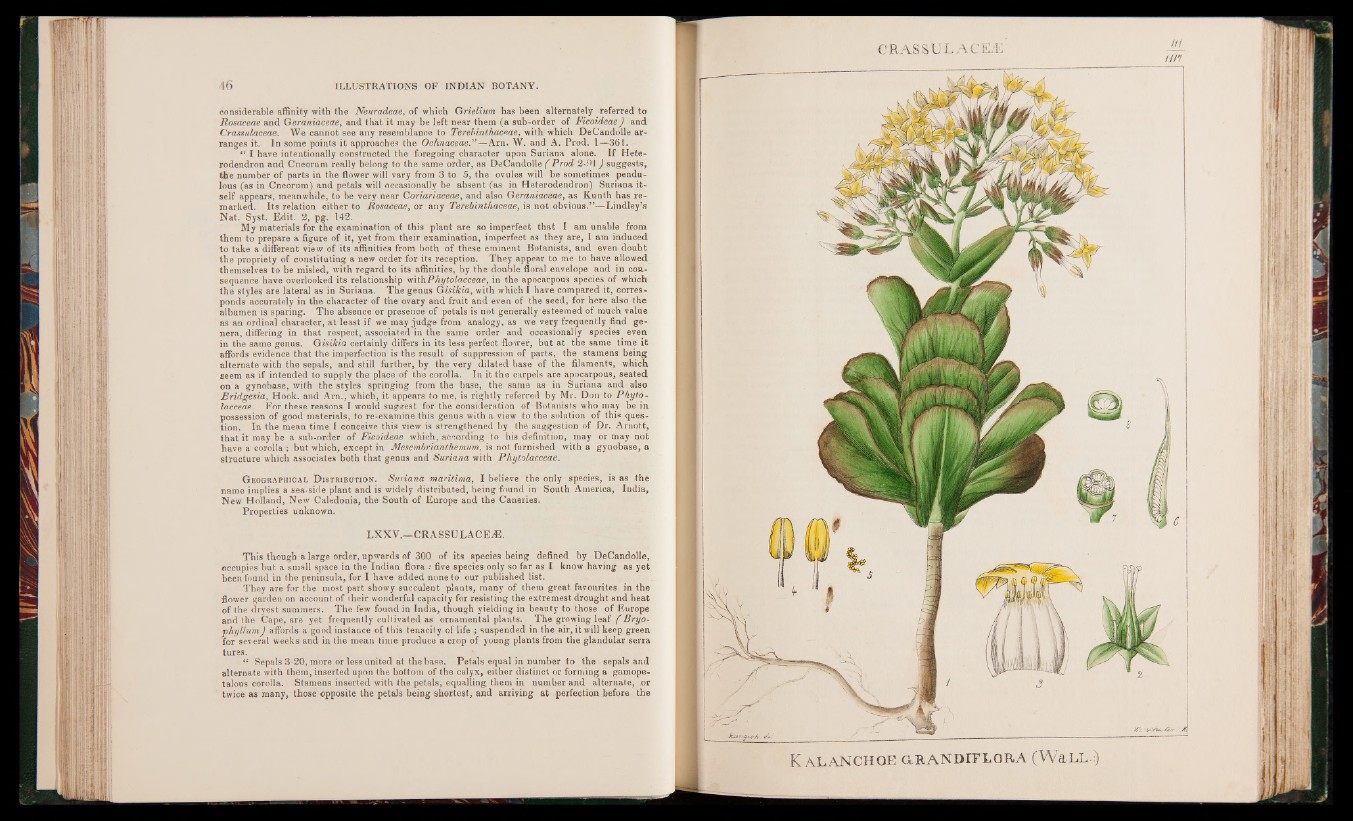
considerable affinity with the Neuradeae, of which Grielium has been alternately referred to
Rosaceae and Geraniaceae, and that it may be left near them (a sub-order of Ficoideae) and
Crassulaceae. We cannot see any resemblance to Terebinthaceae, with which DeCandolle arranges
it. In some points it approaches the Ochnaceae—Am. W. and A. Prod. 1—361.
“ I have intentionally constructed the foregoing character upon Suriana alone. If Hete-
rodendron and Cneorum really belong to the same order, as DeCandolle ( Prod 2*91) suggests,
the number of parts in the flower will vary from 3 to 5, the ovules will be sometimes pendulous
(as in Cneorum) and petals will occasionally be absent (as in Heterodendron) Suriana itself
appears, meanwhile, to be very near Coriariaceae, and also Geraniaceae, as Kunth has remarked.
Its relation either to Rosaceae, or any Terebinthaceae, is not obvious.”—Lindley’s
Nat. Syst. Edit. 2, pg. 142.
My materials for the examination of this plant are so imperfect that I am unable from
them to prepare a figure of it, yet from their examination, imperfect as they are, I am induced
to take a different view of its affinities from both of these eminent Botanists, and even doubt
the propriety of constituting a new order for its reception. They appear to me to have allowed
themselves to be misled, with regard to its affinities, by the double floral envelope and in consequence
have overlooked its relationship withPhytolacceae, in the apocarpous species of which
the styles are lateral as in Suriana. The genus Gisikia, with which I have compared it, corresponds
accurately in the character of the ovary and fruit and even of the seed, for here also the
albumen is sparing. The absence or presence of petals is not generally esteemed of much value
as an ordinal character, at least if we may judge from analogy, as we very frequently find genera,
differing in that respect, associated in the same order and occasionally species even
in the same genus. Gisikia certainly differs in its less perfect flower, but at the same time it
affords evidence that the imperfection is the result of suppression of parts, the stamens being
alternate with the sepals, and still further, by the very dilated base of the filaments, which
seem as if intended to supply the place of the corolla. In it the carpels are apocarpous, seated
on a gynobase, with the styles springing from the base, the same as in Suriana and also
Rridgesia, Hook, and Am., which, it appears to me, is rightly referred by Mr. Don to Phytolacceae.
For these reasons I would suggest for the consideration of Botanists who may be in
possession of good materials, to re-examine this genus with a view to the solution of this question.
In the mean time I conceive this view is strengthened by the suggestion of Dr. Arnotfc,
that it may be a sub-order of Ficoideae which, according to his definition, may or may not
have a corolla ; but which, except in Mesembrianthemum, is not furnished with a gynobase, a
structure which associates both that genus and Suriana with Phytolacceae.
G eographical D istribution. Suriana mantima, I believe the only species, is as the
name implies a sea-side plant and is widely distributed, being found in South America, India,
New Holland, New Caledonia, the South of Europe and the Canaries.
Properties unknown.
LXXV.—CRASSULACEA3.
This though a large order, upwards of 300 of its species being defined by DeCandolle,
occupies but a small space in the Indian flora : five species only so far as I know having as yet
been found in the peninsula, for I have added none to our published list.
They are for the most part showy succulent plants, many of them great favourites in the
flower garden on account of (heir wonderful capacity for resisting the extremest drought and heat
of the dryest summers. The few found in India, though yielding in beauty to those of Europe
and the Cape, are yet frequently cultivated as ornamental plants. The growing leaf ( Bryo-
phyllum) affords a good instance of this tenacity of life ; suspended in the air, it will keep green
for several weeks and in the mean time produce a crop of young plants from the glandular serra
tures.“
Sepals 3-20, more or less united at the base. Petals equal in number to the sepals and
alternate with them, inserted upon the bottom of the calyx, either distinct or forming a gamope-
talous corolla. Stamens inserted with the petals, equalling them in number and alternate, or
twice as many, those opposite the petals being shortest, and arriving at perfection before the
CRASSUL ACEÆ ill
i m
K a LANCHOE aRANDITLORA (WaLL :)